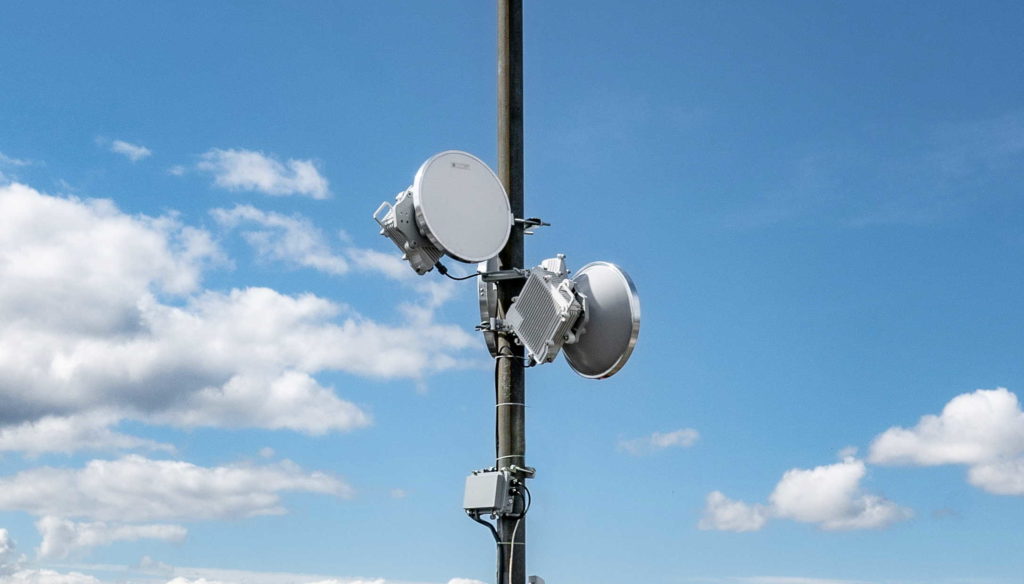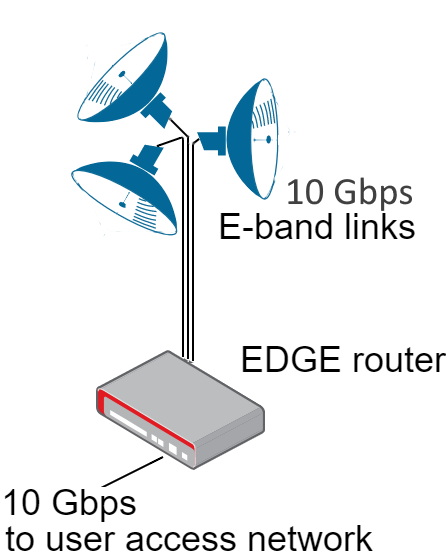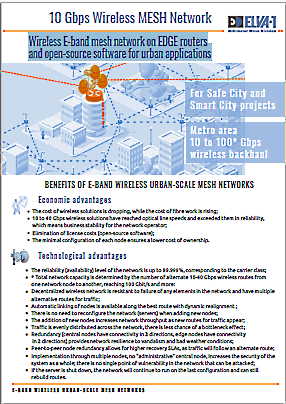
The wireless mesh network is designed to replace or back up 40- or 100-gigabit fiber rings at the city scale. The mesh network operates at 70-80 GHz (E-band) and has a hexagonal topology with sides ranging in size from 1 to 5 km. Each node has three 10 Gbit/s radiolinks (optional 20-40 Gbit/s) operating in full duplex mode. In this topology, each node has three wireless links to neighboring nodes as well as the ability to connect to the operator’s fiber optic network for traffic exchange (if available in that location).
Using a wireless mesh network in cities with populations ranging from 100-200 thousand to millions of people, it is possibly quickly deploy Smart City projects with video surveillance systems, face recognition, traffic control and Internet of Things (various sensors, gas analyzers, ticket machines, etc.), providing gigabit Internet to apartment buildings, business centers, industrial zones.
10Gbps 70-80GHz E-band radio links are ideal for the deployment of wireless mesh network at the city scale.
There are 8 main advantages of 70-80GHz E-band communications compared to technologies based on 802.xx standards:
- Distance range of radio links between the nodes of a mesh network is 3-5 km on average;
- Full-duplex mode 10 Gigabit Ethernet;
- Carrier-grade equipment to deploy 4G/5G base stations;
- Low latency over a large number of hops;
- Low BER (Bit Error Rate), with a difference of up to 6 orders of magnitude compared to Wi-Fi and Wi-Gig;
- Availability rate up to 99.999%;
- Up to 100% of wireless traffic load per radio link;
- Light licensing of 71-76/81-86 GHz spectrum in the most countries.

Each node uses an edge 10GE router (Edge-router) on open-sourse software. It is a type of router located at the edge of the network and is designed to provide connectivity between the user’s network (apartment building, video surveillance node, etc.) and the backhaul mesh network. The router is Linux-based, has 10 Gigabit optical inputs from radiolinks and access to the user’s LAN, low power consumption and remote administration capability.
ELVA-1 emphasizes the differences between this technology and inexpensive Wi-Gig or Wi-Fi counterparts with half-duplex 802.xx protocols. PPC-10G-E radiolinks are full-duplex – so each link is capable of transmitting traffic at 10 Gbps in both directions. For comparison, Wi-Fi or Wi-Gig technologies are half-duplex — the capacity of such a link will be shared between the Up-link and Down-link directions.

For more detail about E-band wireless mesh network, please download product booket:
Wireless E-band mesh network on EDGE routers
and open-source software for urban applications
